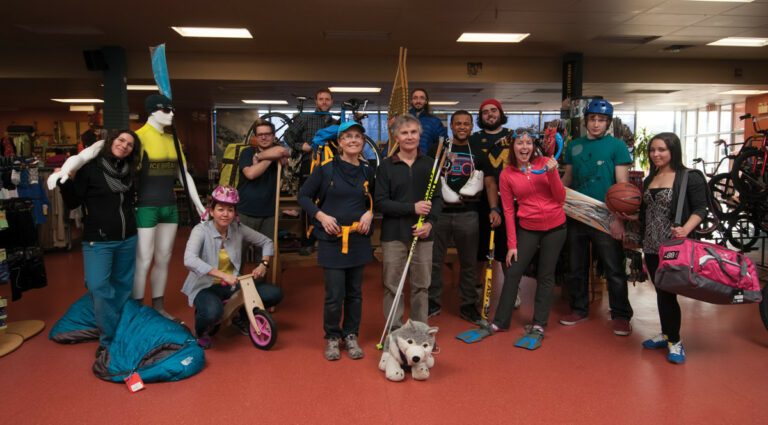On EDGE: Opinion
The intersection where Franklin Avenue meets Taylor, Kam Lake and Old Airport roads is the busiest in the city. For a cyclist caught in the curb lane on Franklin looking for an opening in fast-moving traffic, it’s also potentially the most dangerous.
The safest route from the city centre to Yellowknife’s southern neighbourhoods follows the Frame Lake Trail to Byrne Road, and Woolgar Avenue to Kam Lake Road.
That bit of TK isn’t on the maps dispensed by the Northern Frontier Visitors Centre, where tourists are invited to throw a leg over free bicycles and launch self-guided tours of what may be the least bicycle-friendly city in Canada.
In fact, there is nothing about bicycle routes to be found anywhere in the sheaf of maps, brochures, and booklets dispensed by the Visitors Centre – despite assurances from Dave Hurley, the City’s Facilities Manager, that the documents make sense of Yellowknife’s fragmented trail network.
Hurley is the City’s man on the trail file, and it’s possible that he has never looked at the maps, or that he sees them as a statement of the City’s policy: trails are for recreational use by hikers, runners, strollers and bikers – despite a bylaw that bans bicycles from sidewalks.
The basic City map draws dotted lines to Frame, Niven, Range Lake, and Jackfish lakes and the Prospectors Trail in Fred Henne Park. Those add up to about 15 kilometres of trails, by Hurley’s reckoning, and in theory connect with signed bicycle routes.
“It’s a pretty good network,” says Hurley and costs as much as $30,000 a year for snow and brush clearance and to repair the predations of vandals who vent their emotions on trail-side interpretive signs.
“If you follow established signed routes, you’ll find they are designed to hook up with the trails,” says Hurley. “The routes were designed not for commuting, but to get a rider around the city. They are more for recreation.”
“We’re fortunate to have a network that will take a rider from one end of the city to the other, and takes you by some major public facilities, the museum, the curling rink, the pool, city hall and recreation centre,” says Hurley. “It brings a lot to the city.”
Bike route signs not on maps
The challenge is to find those signed bicycle routes. Except for the painted lines on lower Franklin Avenue, the green on white signs appear out of nowhere, and vanish just as mysteriously. They are not to be found on any of the maps dispensed by the Visitor’s Centre.
The approach reflects City administration’s ambivalence toward cycling. It’s a bias borne of a climate that keeps most bicycles in storage for half the year, and prompts guilty over-compensation in the form of $500,000 lavished on just seven blocks of segregated bicycle lanes on 52nd Ave.
As an alternative, a half-million dollars dedicated to adding a single track to the Ski Club trails or the snowmobile tracks around Jackfish Lake would certainly be used by local riders and would have the potential of drawing visitors to Yellowknife.
Whitehorse has built a reputation as an exotic destination for mountain bikers, with two trails in the city. Yellowknife has ignored that market, and local riders. There is not a kilometre of single-track to be found, and no plans to build any.
Over the course of last summer, while City crews were busy tearing up the street, I kept an eye on 44th Street, where cyclists are expected to turn off Franklin and cross two lanes of traffic to get to 52nd Avenue. I didn’t see a single rider stray from Franklin.
Personally, I avoid Franklin. I don’t like the rhythm of the grade. Within the first year of arriving in Yellowknife in 2000, I rode all of the trails in and around the city that could be ridden and many that dead-ended in bogs or dare-devil descents down slick rock faces.
I got into the habit of taking School Draw Avenue to the old access road to the City pump house and exploring trails on Tin Can Hill, or riding cross on the fire road to Con Mine. The City’s recent changes to Tin Can Hill have bulldozed all the fun out of that route.
My other way to avoid Franklin is a steep trail behind the Racquet Club that climbs up to Niven Lake. A less challenging option turns west off Franklin at 45th Street and hooks up with 49th Avenue, providing access to the city centre and the Frame Lake trail.
Hurley says plans for the future will link the orphaned trail that parallels Dehcho Boulevard to a network that will link up with the rest of the system, giving Yellowknife up to 40 kilometres of general use trails when it’s all done – but nothing dedicated to cycling.






